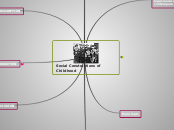Social Constructions of Childhood
CRITICAL ANALYSIS: the social and legal and moral conceptions of childhood historically
TREATMENT OF CHILDREN PRE-ENLIGHTENMENT
“Children were mixed with adults as soon as they were considered capable of doing without their mothers or nannies, not long after a tardy weaning (in other words at about the age of seven) (Aries, 1973:395).
Typically attributed to the work of Philippe Aries and his work, Centuries of Childhood (1973). He was of the view that the notion of ‘childhood’ as we know it contemporarily, was absent in medieval societies.
THE TREATMENT OF CHILDREN POST ENLIGHTENMENT
What has been important in the construction of childhood was the emergence of schooling and the changes and developments of family relationships during the 16th, 17th and 18th centuries.
In Aries view, it is only since this time that we have become preoccupied with the social moral and sexual development of young people.
THE CONSTRUCTION OF CHILDHOOD
Hendrick (1990: 37) identifies no less than five versions of childhood which were articulated during the Victorian era:
The Romantic child, the Evangelical child, the Factory child the Delinquent child and the Schooled child.
FROM VICTIM TO THREAT
As the notion of childhood evolved, the idea that children were a responsibility and children were creatures who possessed the capacity for good and evil. Thus discipline was required to ensure that the former predominated over the latter.
Differing versions of childhood are identified as being reflective of the social conditions of the time rather than as natural or intrinsic qualities of a universal state of childhood.
CRITICAL EVALUATION: the social, legal, moral conceptions of childhood contemporarily
Social reactions to youth and crime
Those of the Whig Tradition sought to save children from the degradation of factory life.
The notion of the Romantic child and all it stood for was seen as being under siege from the brutalization of children in the work place.
Due to the following legislative reform, children were viewed as the urban 'scurge' in inducstrialised towns and cities
The children of the working classes were seen as the biggest social threat.
Legal Responses to youth and crime
Factory Act of 1833
Cited as the cut-off point of these social developments. Enforcement of the act prevented the employment of children under 9 and limited working hours for those aged between 9 and 13.
Youthful Offenders Act, 1854
For the first time, ‘juvenile delinquency’ had been recognised legislatively, ‘as a distinct social phenomenon’.
Hand in hand, the Schooled child and the Delinquent child began to form.
Industrial Schools Act, 1857.
Marks a watershed in the transition to education and schooling for the masses.
Although, Hendricks points out, the history and creation of delinquency and the history and creation of education are separate and different in many respects (Hendricks, 1990:45), the ideological origins of both forms of social regulation are similar.
HISTORY AND CREATION OF DELINQUENCY
Both focus on the special nature of the child,
HISTORY AND CREATION OF EDUCATION
Both view social and physical regulation as vital to both the moral well being of the child and the moral well being of society.
Both are concerned with the practical threat of the unregulated child to the preservation of the social order.
ARE THERE CONSEQUENCES FOR YOUTH FROM SUCH IDEOLOGIES?
Brown (2005:13) suggests, “this institutional framing of childhood within the school and reformatory has had long and profound consequences for the interlinking of youth and crime.”
Criminalisation
the development of more sophisticated surveillance techniques such as philanthropic schooling and policing, made children more problematic and visible.
As in contemporary society, the complex insecurities of the era came to bear upon the young, but this time on ‘youth’, opposed to ‘childhood’.
Regulation
The extension of the period of childhood dependency through a number of legislative and institutional changes
It was against this very backdrop that a construction of youth and adolescent rather than childhood; and a reconstruction of juvenile delinquent were to take place.
Main topic
COMPARE/CONTRACT
HISTORICAL CONCEPTIONS OF CHILDHOOD
Attention was paid to the perceived problem of young males forming street gangs.
Such individuals were experiencing increasing economic and leisurely independence
This occured in parallel with heightened public concern regarding delinquency and hooliganism.
This plethora of crime, defined as displays of public deviance, rowdiness, drunkenness had been termed ‘hooliganism’ and as such had made headlines in the local press and within a few years grew to acquire symbolic stature.
CONTEMPORARY CONCEPTIONS OF CHILDHOOD
Attention is still bring paid to the perceived problem of young males forming street gangs
Such individuals are still experiencing increasing economic and leisurely independence as a result of the current recession
This occured in parallel with heightened public concern regarding delinquency but only this time, the focvus has been on anti social behaviour as opposed to hooliganism
The type of reports that make the headlines in the local press relate to anti social youths which too has grew to acquire symbolic stature in recent years.
Subtopic
DESCRIPTION
Definition of Youth
Provide an official/unofficial definition
Inextricable link between youth and crime
we automatically perceive our younger generations to be out and out delinquent
an examination of the social and legal responses to youth crime
the interlinking between youth and crime can be evidenced by social and legal responses to youth crime both historically and contemporarily
Age appropriate expectations
Society places expectations on young people as well as the expectations of parents, teachers. this creates a degree of strain on the young persons life.
Age-crime curve
The age- crime is one example of how the interlinking between youth and crime can be demonstrated
INTRODUCTION
CONCLUSION
Recap
Aim
Objective
Main points of critical analysis
Main points of critical evaluation
